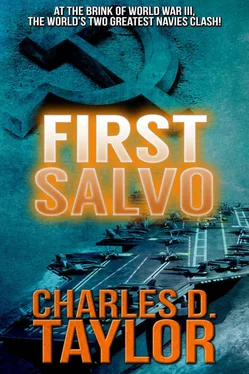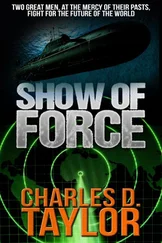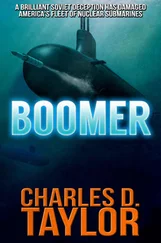The executive officer looked at the chart for a moment with a touch of uncertainty, then back at Nelson. “Admiral Pratt still has tactical command of those pickets, Captain.” He was one of those not yet able to figure out how his commanding officer could assume such responsibilities.
“You’re right. Send another message to Pratt and tell him I will assume command of those frigates immediately.”
“Uh…” The XO couldn’t swallow that one. In his Navy, junior officers were not in the habit of telling an admiral what they were assuming command of. But the XO simply couldn’t think of what to say.
“Just send it, and watch what happens. Okay?” Nelson pushed his baseball cap back on his head in a jaunty manner and grinned at the XO. The meaning of his expression was obvious. It said in no uncertain terms, I know what I’m doing and I know my bounds .
“Right, Captain.”
“And when you get the comm officer set, zip up the ship for the duration. We’re just about in missile range and they have a better idea where we are than we do them. I’m going to need you to run this ship.” It was the way he wanted the XO to see him — a man above the other captains, but also a man who trusted his subordinates, one who would give them all the responsibility they could handle. The XO was a good officer — Nelson had checked his credentials before he’d ever gotten together with Pratt in Washington. He could have asked for another XO, but this man and his ASW training were superb. What the hell , thought Nelson, I might not be too excited about having me for a CO either. But I needed a go-between with the crew, and they understand this guy . A crew needed a known entity and the XO was it.
“Contact!” The voice report echoed across the bridge from sonar a split second before the warning bell went off. A missile was locked on John Hancock !
ABOARD U.S.S. JOHN F. KENNEDY , SOUTHEAST OF MALTA
When Admiral Pratt settled into his chair in flag plot, the displays before him were accurate within seconds. Commander Clark had been made a staff officer because of his brilliance in strategic concepts. Once Pratt made him understand what was expected, Clark was able to deliver. From the moment he entered the room, Pratt knew there would be no necessity for sharp language again. The only element missing was the satellite picture. But that was balanced by the fact that the Russians were no better off in that respect.
Clark eased into the chair next to him. “The Hawkeyes are having a rough time of it, Admiral.”
Pratt’s eyes shot up to the board that displayed the air battle taking place four hundred miles to the east, well to the south of Crete. Colored symbols representing friendly forces were minimal. “Status?” He struck a match to light the stub of cigar between his teeth.
“Our Hawkeyes picked them up as they passed over Bulgaria and commenced jamming, just in case they decided to fire a few early shots to keep us off guard. But it wasn’t too long after that the Hawkeyes got caught in a pincer between MiGs coming down from the north and some fighters that I guess were sent up by Kharkov. That’s one I guess we didn’t expect. Anyway, our fighters arrived on station a few moments after it all started. Our boys hadn’t been able to do much about fighting back. All they could do was jam and evade, and you know how well they can do that.”
“Cut the shit, Commander. How many did we lose?”
“Two of them, sir. They were apparently too close together. We were listening to the net and the controllers were vectoring our Tomcats in when they went off the air.”
Pratt interrupted. “That’s max range for the Tomcats. They should be in closer.” The cigar remained unlit. He tore off his last match.
“We still have recon aircraft out there, Admiral.” It was Clark’s turn, his first since Pratt had come aboard. “I gave the orders for them to haul ass out of there, sir, because we wouldn’t have had any Hawkeyes left if—”
Pratt extended his hands in a gesture of acceptance. “Okay. Okay. No need to outdo my act. I would have done the same thing. Those Russian fighters didn’t have much time on station either, did they?”
“Very little. It was pretty quick, I guess — old-fashioned dogfight for a second. We lost two, claim four of theirs downed, though I think our men in the rear seat tend to exaggerate. But they accomplished what we sent them out for. The other Hawkeyes got away, and we still have a pretty good air picture as a result.”
“Very good, you mean,” Pratt mused. “That’s what I was looking for before.” Now he slapped his pocket, looking for more matches.
“They’ve tried barrage-jamming our picture, but we’re restationed so that LINK is working properly now.” LINK was the process by which the recon aircraft were able to transmit the tactical picture back to Kennedy and Yorktown. It also allowed the controllers in the Hawkeyes to vector the fighters to a target or even to take full control of the craft from the pilot.
“We’ve been able to take about five or six Backfires out of the picture, but, Christ, they just keep coming, one flight after another.”
“That’s the idea. Simple mathematics. It doesn’t matter to Moscow how many planes they lose or how many missiles we knock out as long as enough of them get through. They never designed the goddamn things for perfection. If half-a-dozen missiles break through on us for every fifty they put up there, I’ll bet they’d call that a successful attack.”
Clark pointed at one of the boards. “It looks very successful then, sir.” He handed Pratt a pack of matches.
The attack was successful indeed. The red enemy symbols on the board, each representing a Backfire bomber closing in on their force, were numerous, merging into a single red blob in some sectors. And converging on the intercept point a little over a hundred miles from the battle group were the Hornet fighters, the last source of long-range defense before Pratt’s battle group would have to undertake its own defense.
Pratt viewed the situation dispassionately. The perimeter was already over — the pickets had done their job and now it was up to Nelson. He saw that Nelson’s ASW forces had now come under attack. Their success would be measured in a matter of minutes. If their tactics were successful, the Soviet submarines would neither be able to control the cruise missiles nor launch an attack of their own on the battle group.
The Soviet cruise missiles would be launched shortly. Then it would become an electronic war — missile versus missile, countermeasures versus countermeasures, men versus black boxes. Clark had seen that electronic countermeasures had been instituted before Pratt entered plot. Each ship in the battle group constantly radiated signals that would confuse the incoming missiles, fool the enemy radar into thinking that there were more ships than really existed, that small ships were really carriers, that the carrier was a series of small targets. But Pratt knew there would be more missiles than targets. There were men in those aircraft and submarines who understood American battle group dispositions well enough to know where the carrier was located and which ship was an AEGIS cruiser.
ABOARD U.S.S. YORKTOWN WITH THE KENNEDY BATTLE GROUP
Tom Carleton made a tour of Yorktown after his shower. Since she was secured for action, the PA system was used whenever a hatch was opened to another compartment to allow entry. This served two purposes — many men actually had the opportunity to shake their new commanding officer’s hand before they went into battle, and nothing could have done more for morale than to see the captain apparently as confident as if they were about to take an extended liberty.
Читать дальше












